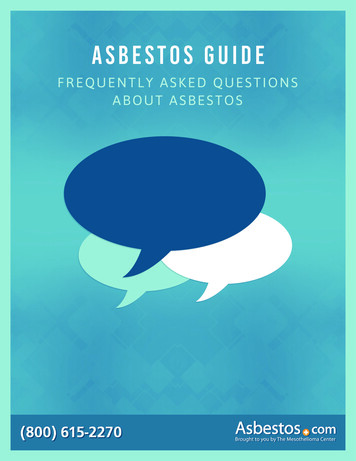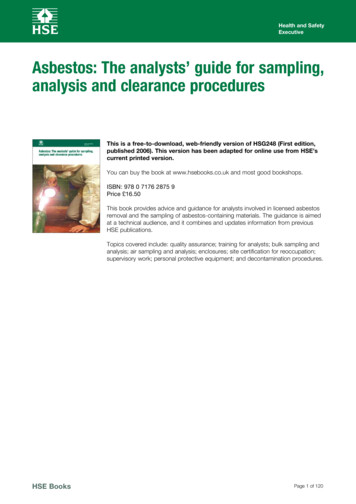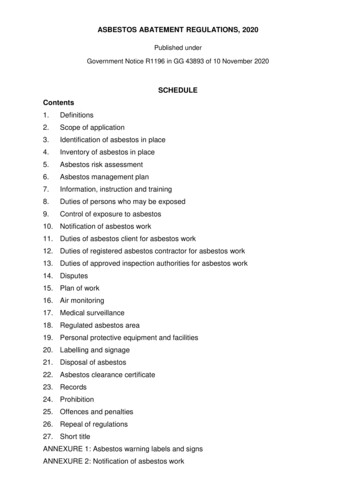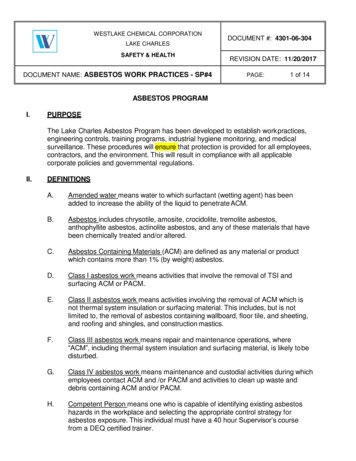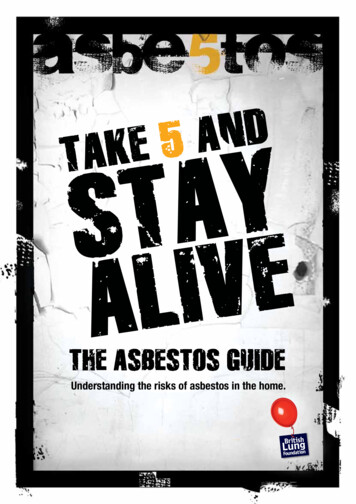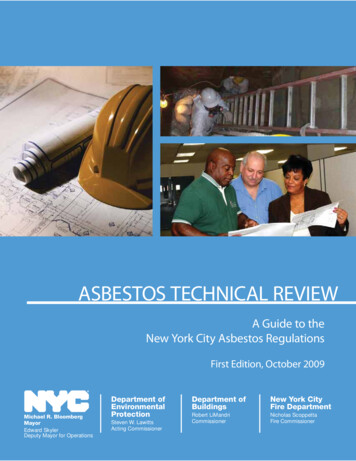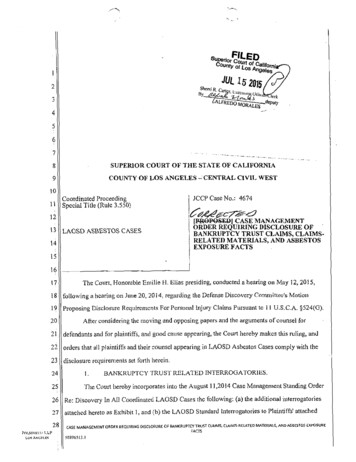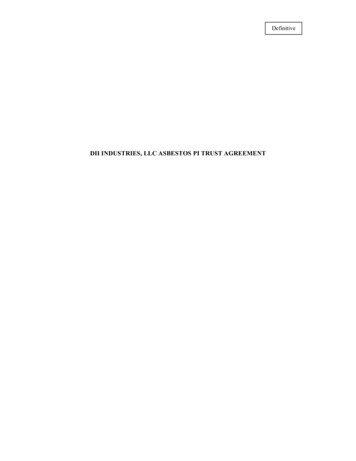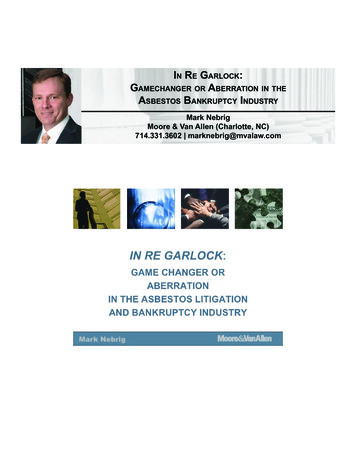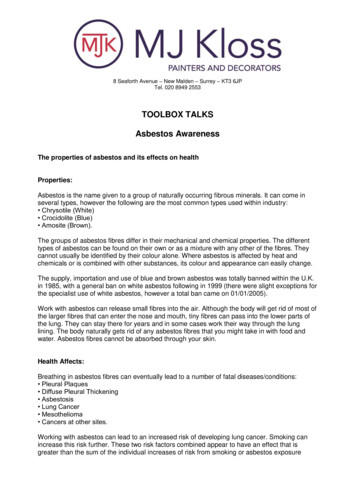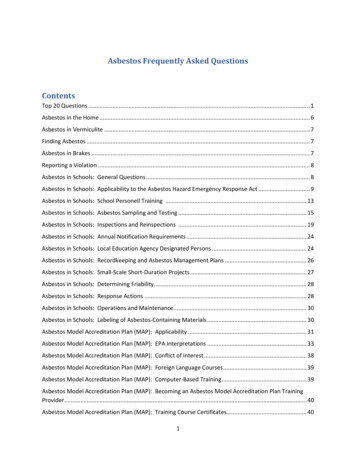
Transcription
Asbestos Frequently Asked QuestionsContentsTop 20 Questions . 1Asbestos in the Home . 6Asbestos in Vermiculite . 7Finding Asbestos . 7Asbestos in Brakes . 7Reporting a Violation . 8Asbestos in Schools: General Questions . 8Asbestos in Schools: Applicability to the Asbestos Hazard Emergency Response Act . 9Asbestos in Schools: School Personell Training . 13Asbestos in Schools: Asbestos Sampling and Testing . 15Asbestos in Schools: Inspections and Reinspections . 19Asbestos in Schools: Annual Notification Requirements . 24Asbestos in Schools: Local Education Agency Designated Persons . 24Asbestos in Schools: Recordkeeping and Asbestos Management Plans . 26Asbestos in Schools: Small-Scale Short-Duration Projects. 27Asbestos in Schools: Determining Friability . 28Asbestos in Schools: Response Actions . 28Asbestos in Schools: Operations and Maintenance. 30Asbestos in Schools: Labeling of Asbestos-Containing Materials . 30Asbestos Model Accreditation Plan (MAP): Applicability . 31Asbestos Model Accreditation Plan (MAP): EPA Interpretations . 33Asbestos Model Accreditation Plan (MAP): Conflict of Interest . 38Asbestos Model Accreditation Plan (MAP): Foreign Language Courses . 39Asbestos Model Accreditation Plan (MAP): Computer-Based Training . 39Asbestos Model Accreditation Plan (MAP): Becoming an Asbestos Model Accreditation Plan TrainingProvider . 40Asbestos Model Accreditation Plan (MAP): Training Course Certificates. 401
TOP 20 ASBESTOS QUESTIONS1. How do I know if I have asbestos in my home (in floor tile, ceiling tile, shingles, siding, etc.)?The only way to be sure whether a material contains asbestos is to have it tested by a qualifiedlaboratory. EPA only recommends testing suspect materials if they are damaged (fraying,crumbling) or if you are planning a renovation that would disturb the suspect material. Samplesshould be taken by a properly trained and accredited asbestos professional (inspector).2. What are the health risks if I have asbestos in my home, building, apartment, or school?Asbestos that is in good condition and left undisturbed is unlikely to present a health risk. The risksfrom asbestos occur when it is damaged or disturbed where asbestos fibers become airborne andcan be inhaled. Managing asbestos in place and maintaining it in good repair is often the bestapproach.3. Where can I find someone to remove the asbestos in my home?You can perform an internet search for “asbestos contractor” and the location of your home.Contact your state to determine what state training and accreditation requirements may exist forboth the contractor and their workers. EPA recommends that you use an asbestos contractor that isproperly trained to handle asbestos.4. My attic has vermiculite insulation in it. Am I at risk? Should I take it out?If you have vermiculite insulation in your home, you should assume this material may becontaminated with asbestos and be aware of steps you can take to protect yourself and your familyfrom exposure to asbestos. The EPA recommends that vermiculite insulation be left undisturbed.Airborne asbestos fibers present a health risk through inhalation, so the first step is to not disturbthe material, which could release fibers into the air. If you disturb the insulation, you may inhalesome asbestos fibers. The degree of health risk depends on how much and how often this occurred.If you choose to remove the vermiculite insulation, this work should be done by a trained andaccredited asbestos abatement contractor that is separate and independent from the company thatperformed the assessment of the vermiculite insulation to avoid any conflict of interest.5. I am thinking about buying a house but it has vermiculite attic insulation in it. Should I have itremoved before or after I buy the house?Removal of the vermiculite insulation may not be necessary if it is confined in a manner where it willbe left undisturbed. If you choose to have the vermiculite insulation removed, the EPA recommendsthat you use a trained and accredited asbestos contractor that is separate and independent fromthe company that performed the assessment of the vermiculite insulation to avoid any conflict ofinterest.2
6. I use/used vermiculite to enhance my potting soil. Should I be concerned?EPA's investigation (see report) into these products indicates that consumers face only a minimalhealth risk from using vermiculite products at home or in their gardens.To further reduce the risk associated with the occasional use of vermiculite products duringgardening activities, EPA recommends that consumers: Use vermiculite outdoors or in a well-ventilated area. Avoid creating dust by keeping vermiculite damp during use. Avoid bringing dust into the home on clothing.Although EPA does not endorse the use of any particular product, consumers may choose touse: Premixed potting soils, which ordinarily contain more moisture and less vermiculite than purevermiculite products and are less likely to generate dust. Soil amendment materials other than vermiculite, such as peat, sawdust, perlite, or bark.7. How do I get certified as an asbestos professional?To become a properly trained and accredited asbestos professional you will need to seek trainingfrom a training provider that offers courses approved by the EPA or a state to conduct asbestostraining pursuant to the Asbestos Model Accreditation Plan. Most states also require a license toperform this work. Your training course completion certificate is a general prerequisite to applyingfor such a license. The training courses vary in length from 2 to 5 days depending upon the type ofwork you wish to perform. Accredited asbestos training courses are offered in five separatedisciplines; Asbestos Abatement Worker, Asbestos Abatement Supervisor, Inspector, ManagementPlanner and Project Designer. Some states may refer to these training disciplines by different, yetsimilar names.8. Where can I find someone to test a material to see if it contains asbestos?You can perform an internet search for “asbestos inspection and assessment” and the location ofyour home. Also, make sure that the inspector is properly trained and accredited by your state.9. I'm remodeling my home. Do I need to be concerned about asbestos in the buildingmaterials?It's not possible for you to tell whether a material in your home contains asbestos simply by lookingat it. If you suspect a material within your home might contain asbestos (for example floor tile,ceiling tile or old pipe wrap) and the material is damaged (fraying or falling apart) or if you areplanning on performing a renovation that would disturb the material, the EPA recommends that youhave it sampled by a properly trained and accredited asbestos professional (inspector). Theprofessional then should use a qualified laboratory to perform the asbestos analysis. Also, you may3
learn more about whether the replacement materials you intend to install might possibly containasbestos by reading the product labels, calling the manufacturer, or by asking if your retailer canprovide you with the Material Safety Data Sheet (MSDS) for the product(s) in question.10. Since asbestos was banned, do I need to be worried about products on the market todaycontaining asbestos?On July 12, 1989, the EPA issued a final rule under Section 6 of the Toxic Substances Control Act(TSCA) banning most asbestos-containing products in the United States. In 1991, the rule wasvacated and remanded by the Fifth Circuit Court of Appeals. As a result, most of the original ban onthe manufacture, importation, processing, or distribution in commerce for most of the asbestoscontaining product categories originally covered in the 1989 final rule was overturned. Only thebans on corrugated paper, rollboard, commercial paper, specialty paper, and flooring felt and anynew uses of asbestos remained banned under the 1989 rule. Although most asbestos containingproducts can still legally be manufactured, imported, processed and distributed in the U.S.,according to the U.S. Geological Survey, the production and use of asbestos has declinedsignificantly.11. Is there still asbestos in automobile brakes?It is possible that some aftermarket brakes, especially imported brakes, may still contain asbestos.12. How do I find out if my child’s school has asbestos in it?The Asbestos-Containing Materials in Schools Rule, pursuant to the Asbestos Hazard EmergencyResponse Act (AHERA) requires schools to make their asbestos management plans available to thepublic, including parents, within 5 working days of the request. The asbestos management planshould discuss the location and type of asbestos-containing materials and any preventive measuresor response actions taken in your child’s school. You can also contact the school's AHERADesignated Person directly for more information, or if you have specific questions about asbestos inyour child's school. The AHERA Designated Person’s name and contact information appears in themanagement plan.13. Was my school required to be inspected for asbestos?Yes, unless the building architect or project engineer responsible for the construction of the schoolbuilding certified in writing that no asbestos materials were used in the building’s construction.Otherwise, all public and non-profit private primary and secondary schools need to be inspected forasbestos. The results of the inspections and all re-inspections, required every three years, arecontained within the schools asbestos management plan. A complete and up-to-date copy of theasbestos management plan is required to be housed in the school’s administrative office.4
14. My child’s school has asbestos in it. Why aren't they taking it out?Local education agencies (e.g., school districts) are required under the asbestos-containing materialsin schools rule, pursuant to the Asbestos Hazard Emergency Response Act (AHERA) to inspect forand manage asbestos containing materials properly through the development and implementationof an asbestos management plan. The local education agency can safely and effectively "manage inplace" asbestos-containing materials that are in good condition. The risk from asbestos is when it isdamaged and/or disturbed and asbestos fibers become airborne where they can be inhaled. If thelocal education agency does perform a “response action” or an asbestos abatement, they must useproperly trained and accredited asbestos professionals to do this work. Local education agencies arerequired to undertake timely and appropriate maintenance or response actions whenever asbestoscontaining materials become friable.15. Is the school district required to do anything about asbestos in its school buildings?Yes. The Asbestos Hazard Emergency Response Act (AHERA) was passed by Congress in 1986. AHERArequires public school districts and non-profit private schools to inspect their schools for asbestoscontaining building material and prepare management plans which recommend the best way toreduce the hazard from any asbestos-containing materials that may be present. Options includerepairing damaged asbestos-containing material (such as spraying it with sealants, enclosing it) orremoving it. The plans must be developed by accredited management planners and submitted tothe State. The school authority must notify parent, teacher and employee organizations of the plans,and then the plans must be implemented. The school district must also perform periodicsurveillance of asbestos-containing material every 6 months in its schools. AHERA also requiresaccreditation of abatement project designers, abatement workers, supervisors, and buildinginspectors.16. What is an asbestos management plan?An asbestos management plan is required to provide documentation of the recommended asbestosresponse actions, the location of asbestos within the school, and any action taken to repair orremove the material. The school authority must maintain records to be included in the AsbestosManagement Plan. These records include among other things: List of the name and address of each school building and whether the building has asbestoscontaining building material, and the type of asbestos-containing material.Date of the original and each subsequent school re-inspection.The plan for re-inspections, and operation and maintenance.A blueprint that clearly identifies the location and condition of all asbestos-containingbuilding material that remains in the school.A description of any response action or preventive measures taken to eliminate or controlasbestos exposure.A copy of the analysis of any building material, and the name and address of any laboratorythat sampled the material.5
The name, address, and telephone number of the “designated person” to ensure the dutiesof the local education agency (LEA) are carried out.A description of steps taken to inform workers, teachers, and students or their legalguardians about inspections, re-inspections, response actions, and periodic surveillance.17. Does this management plan have to be updated periodically?Yes. The asbestos management plan must be updated with information collected during periodicsurveillance every 6 months, re-inspections every 3 years, and every time a response action is takenwithin the school. Also, records of annual notifications to parents, teachers, and staff concerning theavailability of the school’s asbestos management plan must be included within the asbestosmanagement plan files.18. Does my school district know where the asbestos in its school buildings is located?They are required to know and to describe where the material is located in the asbestosmanagement plan, and also to monitor and record any change in its condition that might pose apotential safety risk.19. How can we have the air tested in my school?AHERA only requires air testing following an asbestos response action (e.g., asbestos repair orremoval activity) to determine whether the activity has been properly completed. This is done bymeasuring the amount of asbestos in the air where the asbestos response action took place, and isreferred to as "clearance." However, the local education agency, e.g., the school district, may hire aqualified consultant to test its air at any time, as may be needed or appropriate.20. Is it dangerous to have asbestos containing material in my school?Not necessarily. Undamaged asbestos that is properly managed in place poses little health risk tostudents, teachers and other school occupants. However, it is important that the proper schooldesignated authorities regularly inspect the condition of asbestos-containing materials to ensurethey remain intact. Asbestos can pose a health hazard when it is disturbed and asbestos fibersbecome airborne where they can be inhaled. Undamaged non-friable asbestos is best leftundisturbed and managed in place. If done improperly, removing asbestos has the potential tocreate a greater health risk than leaving it undisturbed.ASBESTOS IN THE HOME1. Does a home seller have to disclose to a potential buyer that a home contains asbestos? Whatabout vermiculite?Federal law does not require the seller to disclose to a buyer that their home contains asbestos orvermiculite. State or local requirements may require disclosure. Contact your state about suchrequirements.6
2. Does the EPA have money available for homeowners to pay for asbestos testing or asbestosremoval?The EPA does not have funding available to homeowners for asbestos testing or removal.3. My neighbor is re-siding and re-roofing his house and there is material all over the ground. Do Ineed to be worried about asbestos exposure?Not all house siding or roofing materials contain asbestos. If you are concerned the material mightcontain asbestos, you can ask your neighbor whether or not the material has been tested forasbestos. Federal regulations regarding renovations or demolitions of asbestos-containing materialsdo not apply to a homeowner’s renovation of their home. State or local regulations may beapplicable if the siding or roofing materials do contain asbestos. Contact your state regulatoryagency or local government building department about such requirements.4. I found out the cement water pipes leading to my house (business) contain asbestos. Whatshould I do?If the pipes are damaged they should be properly repaired or replaced by your water utility. Formore information on asbestos in drinking water cinformation/asbestos.cfmASBESTOS IN VERMICULITE5. Can I take vermiculite insulation out myself?Federal asbestos regulations do not apply to work that you perform in your own home, but the EPAstrongly recommends that you not attempt to remove vermiculite insulation yourself. Instead, theEPA strongly recommends that you hire a properly accredited asbestos contractor if you need tohave vermiculite insulation removed from your home.FINDING ASBESTOS6. Does dry wall or sheet rock contain asbestos?There is no way to know whether these materials contain asbestos without having them tested. Ifyou are concerned those materials in your home may contain asbestos and the materials aredamaged (frayed, falling apart) or if you are performing a renovation that will disturb the material,consult with a state accredited asbestos assessment/inspection firm.ASBESTOS IN BRAKES.7. I have changed my brakes in the past, should I be worried about asbestos exposure?Because some, but not all, automotive brakes and clutches available or in use today may containasbestos, professional automotive technicians and home mechanics who repair and replace brakesand clutches can potentially be exposed to asbestos dust. Brake and clutch dust can be seen when a7
brake disk, drum, clutch cover, or the wheel is removed from a car, truck, or other equipment. Thereare also many small dust particles that cannot be seen with the eye. If the brakes contain asbestos,the dust may contain asbestos fibers, which could be inhaled. The greater the exposure is toasbestos, the greater the chance of developing harmful health effects. Disease symptoms may takemany years to develop following exposure. If you are concerned about possible exposure, consult aphysician who specializes in lung diseases (pulmonologist). For more information ure.htmlREPORTING A VIOLATION8. How can I report a suspected asbestos violation?You may submit a tip through an online form on the EPA website at: http://www.epa.gov/tips/ASBESTOS IN SCHOOLS:General Questions9. I thought asbestos was banned and then removed from schools years ago?Asbestos-containing materials, with few exceptions, are not currently banned in the United Statesand are still “managed-in-place” in schools. Under requirements set forth by the Asbestos HazardEmergency Response Act (AHERA) these asbestos-containing materials in schools must be managedin an undamaged and non-friable condition10. I found out that my child’s school has asbestos in it. Is there a risk to him (her)?If done properly, asbestos-containing material that is in good condition can be safely managed inplace. Local education agencies (e.g. , school districts) are required under the asbestos-containingmaterials in schools rule, pursuant to the Asbestos Hazard Emergency Response Act (AHERA), toinspect for and manage asbestos containing materials properly. Asbestos may be a risk when it isdamaged and/ or disturbed and asbestos fibers become airborne and can be inhaled.11. Are schools supposed to notify parents if their child attends a school that has asbestos in it?Yes. The asbestos-containing materials in schools rule, pursuant to the Asbestos Hazard EmergencyResponse Act (AHERA), requires local education agencies (e.g. ,school districts) to notify buildingworkers (including teachers) and parents annually regarding asbestos-related activities such asasbestos inspections, and response actions (abatements). The local education agency must alsoannually notify parent, teacher and employee organizations regarding the availability of theirschools’ asbestos management plans.8
12. If my children have been in a building with asbestos, do they need to see a physician? If Itaught in a building with asbestos, do I need to see a physician?Not necessarily. Asbestos does not pose a health risk if it is managed properly. However, if you feelyou may have been exposed to asbestos fibers in the air, you should consult with a physician thatspecializes in lung disorders or occupational exposures.13. Who is responsible for overseeing the management of asbestos in a school building?The school district/local education agency must nominate a “designated person” to perform anddelegate, if necessary, the management of asbestos in a school building. This person is also aresource for the entire school community who can answer specific questions and address specificconcerns about the presence or management of asbestos in that particular school.14. I have seen the janitor machine-cleaning the floor tile in our school. Should I be worried thatthese machines will degrade the tiles and create a hazard?Machine-cleaning of floor tile can be part of a good maintenance program for asbestos-containingfloor tiles, as long as the machine is operated properly and the tiles are not in poor condition. EPAhas issued special guidance on the proper maintenance of asbestos-containing floor tiles, and theguidance is available from the TSCA Hotline at (202) 554-1404. Undamaged, well maintained floortiles present little risk to students, teachers, and school staff.15. Who is responsible for overseeing the asbestos-in-schools regulations?EPA is the primary governmental agency responsible for enforcing the regulations promulgatedunder AHERA. However, if your State has been issued a "waiver" (or delegation of programauthority), the State agency then becomes responsible for enforcing these requirements. The statesthat currently have waiver programs are: Connecticut, Colorado, Louisiana, Massachusetts, Maine,Oklahoma, Rhode Island, Texas, Utah, Illinois, Kentucky, and New Hampshire.Applicability to the Asbestos Hazard Emergency Response Act16. Q: Are churches that have Sunday school classes, daycare centers, or kindergartensregulated under the Asbestos Emergency Response Act (AHERA)?A: The Asbestos Hazard Emergency Response Act (AHERA) applies to public and privatenon-profit elementary and secondary schools. The term ‘non-profit elementary orsecondary school’ means any elementary or secondary school as defined in section 198 ofthe Elementary and Secondary Education Act of 1965. Under this Act, the terms elementaryand secondary schools refer to day or residential schools which provide elementary orsecondary education determined under state law. Sunday school classes and daycareaccommodations would not be subject to AHERA. However, kindergarten classes conductedin a church may be covered under the Act. Whether or not kindergarten classes conductedin a particular church are subject to AHERA would depend on the stipulations of the stateeducation law in the state in which the church is located. If state law defines elementary9
and secondary education as K through 12, then that part of the church where kindergartenclasses are conducted would be subject to AHERA because the classroom would be includedunder AHERA’s definition of “school building.”17. Q: Do the Asbestos Hazard Emergency Response Act (AHERA) requirements in 40 CFRpart 763 mandating routine facility inspections and management plan developmentapply to for-profit private schools as they apply in public K-12 schools?A: AHERA requirements for facility inspections and management plan development do notapply to for-profit private schools, but they do apply to non-profit private K-12 schools. Thisexemption for private for-profit schools was directly mandated in the enabling legislation(the AHERA statute).18. Q: Is a nursery/daycare center subject to the Asbestos Hazard Emergency ResponseAct (AHERA)?A: Generally no. Nursery/daycare centers are generally not subject to AHERA because theygenerally do not fall within the definition of “school” under AHERA or the asbestos inschools rule. However, if a nursery/daycare center did fall within the definition of “school”(based on how a school is defined under state law), then all parts of the facility that wouldbe considered a school building under 40 CFR part 763.83 would be covered.19. Q: If a private school has a daycare area, is the daycare area excluded from the ruleand/or the whole educational facility?A: If the private school is non-profit, then all parts of the facility that would be considereda school building under 40 CFR part 763.83 would be covered. Conversely, if the privateschool is a for-profit institution, neither the school nor the daycare center would be subjectto the regulation.20. Q: Are vocational schools covered under the Asbestos Hazard Emergency ResponseAct (AHERA)?A: Vocational schools that provide elementary or secondary education under state law arecovered as schools under AHERA.21. Q: Are private for-profit schools included under the Asbestos Hazard EmergencyResponse Act (AHERA)?A: No. Private for-profit schools are not covered under AHERA. This is a statutoryexemption.10
22. Q: Does the Asbestos Hazard Emergency Response Act (AHERA) apply to schools onmilitary bases?A: Yes. AHERA applies to all public and private non-profit elementary and secondaryschools, which includes schools on military bases.23. Q: Are state-run schools (e.g. prison schools, schools for students with disabilities,etc ) covered by the Asbestos Hazard Emergency Response Act (AHERA)?A: The definition of “school” under AHERA covers any elementary or secondary school asdefined by state law. Thus, reference to state law would determine whether a state-runschool is covered as an elementary or secondary school and therefore covered by AHERA.However, state for-profit private schools are expressibly exempted under AHERA andtherefore not covered.24. Q: Several public high school students take advanced placement classes with collegefreshmen at the State University. Does a classroom or building that these studentsfrequent have to be inspected?A: No. The Asbestos Hazard Emergency Response Act (AHERA) § 203 refers to schoolbuildings under the authority of a local education agency (LEA). State university classroomsare not under an LEA’s authority, and therefore are not covered.25. Q: Are the school district’s administrative offices (such as the Board of Education orthe Superintendent’s Office) covered by the Asbestos Hazard Emergency Response Act(AHERA), even if students never attend classes in these buildings?A: Yes. Among the structures covered in the definition of “school building” in AHERA(section 202) and in the asbestos in schools rule (40 CFR part 763.83) are ". any otherfacility used for the instruction or housing of students or for the administration of educationor research programs."26. Q: Are the school system’s maintenance or storage facilities (e.g., bus garage orwarehouse) covered by the asbestos in schools rule?A: In general, the answer is yes. Section 202 of the Asbestos Hazard Emergency ResponseAct (AHERA) defines “school building” to include “. any maintenance, storage, or utilityfacility, including any hallway, essential to the operation of any facility described” in thestatute’s definition of “school building.” Some of the facilities specifically mentioned in thedefinition of school building include classrooms, libraries, gymnasiums, and administrativeoffices. For purposes of the rule, the facility is deemed essential if the local educationagency(LEA) uses the facility.
2. What are the health risks if I have asbestos in my home, building, apartment, or school? Asbestos that is in good condition and left undisturbed is unlikely to present a health risk. The risks from asbestos occur when it is damaged or disturbed where asbestos fibers become airborne and can be inhaled.
